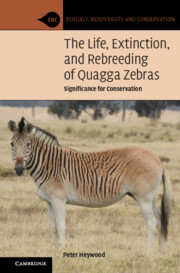Book contents
- The Life, Extinction, and Rebreeding of Quagga Zebras
- Ecology, Biodiversity and Conservation
- The Life, Extinction, and Rebreeding of Quagga Zebras
- Copyright page
- Dedication
- Contents
- Acknowledgments
- Introduction
- 1 Zebras
- 2 Quaggas
- 3 Coat Coloration
- 4 Quaggas, Zebras, and Humans in Southern Africa
- 5 Quaggas Abroad
- 6 Extinction
- 7 Afterlife
- 8 Rebreeding
- 9 Identity and Conservation
- Book part
- Notes
- Bibliography
- Index
2 - Quaggas
Published online by Cambridge University Press: 30 April 2022
- The Life, Extinction, and Rebreeding of Quagga Zebras
- Ecology, Biodiversity and Conservation
- The Life, Extinction, and Rebreeding of Quagga Zebras
- Copyright page
- Dedication
- Contents
- Acknowledgments
- Introduction
- 1 Zebras
- 2 Quaggas
- 3 Coat Coloration
- 4 Quaggas, Zebras, and Humans in Southern Africa
- 5 Quaggas Abroad
- 6 Extinction
- 7 Afterlife
- 8 Rebreeding
- 9 Identity and Conservation
- Book part
- Notes
- Bibliography
- Index
Summary
The morphology of quaggas, their taxonomy, habitats, and behaviors are described. Photographs, illustrations, and taxidermy specimens are employed to examine representations and descriptions critically, for example, did quaggas have horse-like tails, and were Daniell and Harris correct in their illustrations of body striping? My analysis of taxidermy specimens shows sexual dimorphism: stallions were slightly smaller than mares, which is unlike the situation in other subspecies of plains zebras. Quaggas, named Equus quagga by both Boddaert and Gmelin, lived in a variety of habitats in the Cape Colony and Orange Free State (areas that are now part of the Western Cape, Eastern Cape, Northern Cape, and the Free State provinces) including: the nama Karoo, succulent Karoo, fynbos, Albany thicket, savanna, and grassland biomes. A quagga breeding group consisting of a stallion, several mares, and their foals often joined other breeding groups to form a herd. Quaggas often grazed with wildebeests (gnus) and ostriches, and all three species probably benefitted from this association; these animals often migrated together in large numbers seeking grazing and water.
- Type
- Chapter
- Information
- The Life, Extinction, and Rebreeding of Quagga ZebrasSignificance for Conservation, pp. 22 - 50Publisher: Cambridge University PressPrint publication year: 2022

